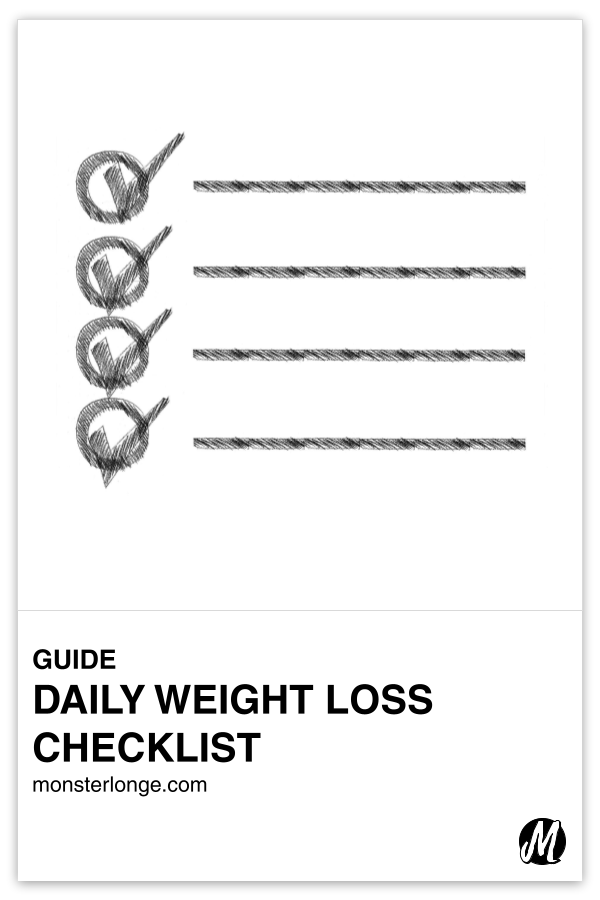
Daily Weight Loss Checklist
Need to lose weight?
More than 73 percent of U.S. adults are overweight or obese, so if you’re an adult who’s reading this in the U.S., then the odds are high that you do indeed need to lose weight.
So how are you gonna go about doing that?
Yup, with the provided checklist, which is nothing more than an inventory of small changes you can make to your everyday life!
And what if you’re not a U.S. adult who’s reading this? Well, considering that the U.S. is exporting its fast food culture all over the globe because who the fuck doesn’t want to eat processed garbage that’s either overwhelmingly salty or excessively sweet to mask how garbage the food is, it’s only a matter of time before your country becomes Americanized in the waistline. So it also behooves you to take heed of the provided checklist for future reference!
Daily Weight Loss Checklist
• Consume at least 20g of protein within 20 minutes of waking up.1Example:
• 3 whole eggs
• 5 egg whites
• 8 oz Greek yogurt or cottage cheese
• 1 scoop whey protein powder mixed with water
• 1/2 scoop whey protein powder mixed with 8 oz milk
NOTE: Research has found that starting the day with a protein-rich breakfast can help you eat less over the course of the day. Apart from that, there’s nothing inherently special about eating the suggested amount of protein at the suggested time. Its mention here is only as a device that’s easy to remember and apply.
• Eat at home instead of ordering take-out or delivery.2Fast food and restaurant meals are usually higher in sodium, sugar, fat, and calories than food that’s prepared at home.
• Bring your own food with you to work or elsewhere.3You’re less likely to eat food that doesn’t align with your nutritional needs when you have food that’s available. This goes along with the previous footnote.
• Add fruit, veggies, and other fiber sources to every meal to help fill you up.4Aim for a daily total of 4 ½ cup servings of fresh or frozen fruit and 5 ½ cup servings of veggies, which can also be fresh or frozen.
Canned fruits and vegetables are also an option but there are precautions to take. When purchasing canned fruit, stay away from varieties that are canned in light or heavy syrup. Instead, buy fruit that’s canned in water, 100% juice, or the fruit’s own juice. For canned vegetables, look for those that are labeled “no salt added” or “low sodium.” When purchasing cans labeled “low sodium”, as well as “reduced sodium”, you can lessen the sodium content even more by rinsing the vegetables.
• Make sure every meal has protein for its satiating effects.5Protein is not only filling but it also helps the body burn calories because it requires a lot of energy to digest and process. For these reasons, protein should play a role in your daily nutrition. Regarding that, the exact amount of protein you should consume depends on a myriad of factors, one of which is your activity level. As a general guideline, you should aim for at least 0.8g of protein per lbs of body weight.
• Serve your meals on salad plates or bowls for easy portion control.6The bigger the plate or bowl, the more likely you are to serve more food than necessary to fill the empty space.
• Wait 30 seconds between bites.7When you eat, appetite-regulating hormones help let the brain know how much you should eat to feel full. Eating too quickly doesn’t give the brain time to pick up on these signals, which makes it easy to consume more food than was needed.
• Eat only when you’re really hungry — not bored, sad, angry, etc.
• Eat only while sitting down at a table and with absolutely no distractions.8Multitasking while eating, such as watching TV or working on the computer during a meal, can prevent you from paying attention to your body’s hunger and satiety signals that regulate appetite.
• Substitute water for fruit juice, soda, sports and energy drinks, and other high-calorie beverages.
• Brush your teeth after the last meal to curb the desire to eat again later.9Brushing your teeth won’t do anything to help you lose weight directly. What it does is help you indirectly because after going through the process of flossing and brushing, you’re more than likely not going to want to eat a snack and take in more calories than you should for fear of having to repeat it again.
• Use a food diary or app to track and manage everything that’s eaten.
• Walk for at least 10 minutes after lunch to burn calories.
• Work out for at least 20 minutes at a moderate intensity.10If weightlifting or doing bodyweight exercises, focus primarily on compound exercises like squats, deadlifts, push-ups, lunges, and other movements that involve multiple body parts rather than just one. These types of exercises have greater calorie-burning potential than isolation exercises, or movements that only work one muscle group at a time, such as chair dips and dumbbell curls.
• Go for a 10-minute walk after dinner to sneak in even more exercise.
• Aim to walk no less than 5,000 steps for the entire day.
• Record activity in a journal or app to stay aware and improve consistency.
• Stop caffeine intake 4 to 6 hours before bedtime to minimize sleep problems.
• Plan and/or prepare meals and snacks for the next day before bed.
• Go to bed at a time that allows for at least 7 hours of sleep.11Sleep deprivation can impact the production and effect of several appetite hormones, such as leptin and ghrelin.
Glossary: calories, deadlift, dietary fat, exercise, hormones, intensity, squats, work out
